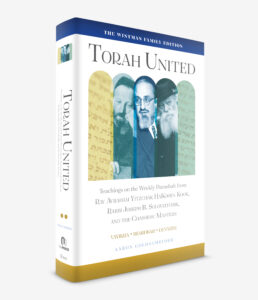Excerpted from Rabbi Aaron Goldscheider’s Torah United: Teachings on the Weekly Parasha from Rav Avraham Yitzchak HaKohen Kook, Rabbi Joseph B. Soloveitchik, and the Chassidic Masters, co-published by OU Press and Ktav Publishing House
 One of the Torah’s most curious laws is the commandment in Parashat Ki Tetze to shoo away the mother bird before taking her eggs or chicks. The Rambam offered reasons for many mitzvot in his Moreh Nevuchim (Guide for the Perplexed), and regarding this mitzvah he claimed that it is grounded in compassion.
One of the Torah’s most curious laws is the commandment in Parashat Ki Tetze to shoo away the mother bird before taking her eggs or chicks. The Rambam offered reasons for many mitzvot in his Moreh Nevuchim (Guide for the Perplexed), and regarding this mitzvah he claimed that it is grounded in compassion.
The mother bird has an inordinate love for her young, which extends even to the eggs. Though these inanimate objects bear no resemblance to her, she selflessly devotes herself to them. She roosts on them for weeks, barely eating and drinking herself, keeping them warm all the time, until the day she at long last sees her chicks emerge from their shells. It follows that it must be horrifying for her to witness the object of her devotion taken from her. This explains why the Torah repeats the words “the chicks or the eggs” twice in one verse (Deuteronomy 22:6) – the mother’s love for her young is strong even when they are seemingly lifeless beings.
This humane, sensitizing rationale seems to contradict a Talmudic ruling. The Mishnah says, “If someone says [in prayer] ‘Your mercies reach even a bird’s nest,’ . . . he must be silenced.” According to one opinion in the Talmud, we silence the person “because He makes God’s acts into mercy when they are only decrees.” This seems to be telling us not to try to rationalize the mitzvot, because they are beyond the human intellect. They should be performed as the pure manifestation of God’s will alone.
The Rambam in fact codified this law in his Mishneh Torah, and even elaborated on this approach against rationalizing the mitzvot in his commentary on this Mishnah:
One who says this is to be silenced, because he is attributed the reason behind the mitzvah to the Holy One’s mercy on fowl. But this is not so, for were it a matter of mercy, He would not have allowed the slaughtering of animals at all. Rather, it is an accepted commandment that has no reason.
An obvious difficulty arises: How can the Rambam be following the ruling of this mishnah when he himself suggests a reason for this mitzvah in his Moreh Nevuchim? And how can he suggest the very reason he himself says does not hold water?
Rav Avraham Yitzchak Hakohen Kook offered a clarification that touches on larger themes. If we pay attention to the context of the aforementioned mishnah, we will see that is referring only to the context of prayer. When a person is studying Torah and engaged in elucidating the essence of the mitzvot, there is ample room to speculate about the rationale for the commandments. Investigation and in-depth analysis is central to Torah study. Prayer, however, is not a time for conjecture and sharp analysis. It demands purity of heart and clarity of mind. When we pray to God our goal should be closeness with our Creator and unconditional devotion to fulfill His will.
Rav Kook penned the following words expressing this notion:
Proper prayer results only from שֶׁבִּשְׁעַת הַתְּפִלָּה הַמְַעֲשִׂית הֲרֵי
the thought that in truth the soul הַתְּפִלָּה הַנִּשְׁמָתִית הַתְּדִירִית הוּא
is constantly praying. She longs for ,מִתְגַּלֶּה בְּפֹעַל. וְזֶהוּ עִדּוּנָהּ וְעִנּוּגָהּ
and flies to her Beloved without ,הֲדָרָה וְתִפְאַרְתָּהּ, שֶׁל הַתְּפִלָּה
cease . . . this is the delicacy and שֶׁהִיא מִתְדַּמָּה לְשׁוֹשַׁנָּה הַפּוֹתַחַת
loveliness of prayer. She is likened to אֶת עָלֶיהָ הַנָּאִים לִקְרַאת הַטַּל אוֹ
a rose who opens her beautiful נוֹכַח קַרְנֵי הַשֶּׁמֶשׁ הַמּוֹפִיעִים עָלֶיהָ
petals to receive the dew or the sun’s .בְּאוֹרָה
rays of light.
It is not uncommon to find people, even very observant people, studying Talmud or other texts during prayer. Humorously, some have suggested that chazarat ha-shatz, the repetition of the Amidah, be renamed chazarat ha-Shas, reviewing the Talmud. Rabbi Moshe Feinstein was asked if this common practice is permitted, and he enumerated three reasons why it is not.
First, at least ten men need to be attentive to every word of chazarat ha-shatz. If their attention is elsewhere, even on Torah, this requirement is not met. Second, everyone present is obligated to answer amen after each blessing. Finally, even if they make sure ten are paying attention and answer every blessing, fulfilling both criteria, others present might misunderstand and assume that learning is unconditionally permitted.
To these halachic concerns, Rav Kook would have added another critical point. Engaging in Torah learning during time dedicated for prayer undercuts the very character and goal of prayer. It encroaches on the emotions and spirituality we endeavor to actualize in these moments. Rav Kook cited the following Talmudic dictum that corroborates this thesis: “The time for prayer is separate from the time for studying Torah” (זְמַן תְּפִילָּה לְחוֹד וּזְמַן תּוֹרָה לְחוֹד).
Torah study and prayer are two of the most natural, powerful, and parallel paths to deepening our relationship with the Almighty. In order to reap their cherished rewards, each requires its own mindfulness and wholehearted attention.

